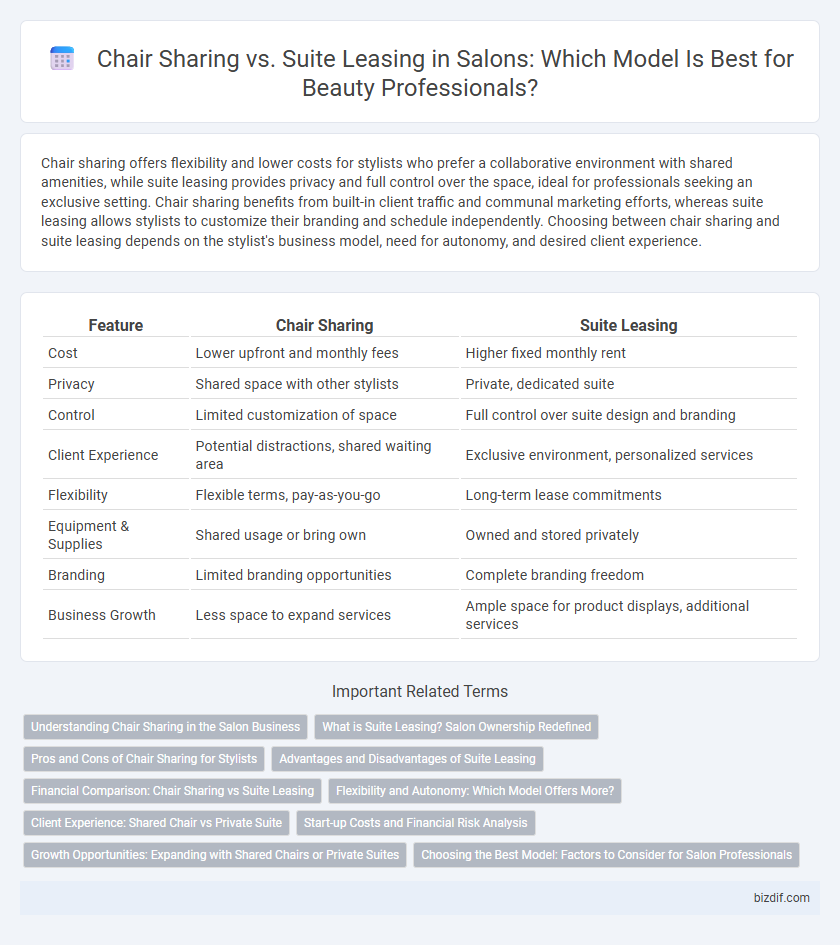Chair sharing offers flexibility and lower costs for stylists who prefer a collaborative environment with shared amenities, while suite leasing provides privacy and full control over the space, ideal for professionals seeking an exclusive setting. Chair sharing benefits from built-in client traffic and communal marketing efforts, whereas suite leasing allows stylists to customize their branding and schedule independently. Choosing between chair sharing and suite leasing depends on the stylist's business model, need for autonomy, and desired client experience.
Table of Comparison
| Feature | Chair Sharing | Suite Leasing |
|---|---|---|
| Cost | Lower upfront and monthly fees | Higher fixed monthly rent |
| Privacy | Shared space with other stylists | Private, dedicated suite |
| Control | Limited customization of space | Full control over suite design and branding |
| Client Experience | Potential distractions, shared waiting area | Exclusive environment, personalized services |
| Flexibility | Flexible terms, pay-as-you-go | Long-term lease commitments |
| Equipment & Supplies | Shared usage or bring own | Owned and stored privately |
| Branding | Limited branding opportunities | Complete branding freedom |
| Business Growth | Less space to expand services | Ample space for product displays, additional services |
Understanding Chair Sharing in the Salon Business
Chair sharing in the salon business refers to multiple stylists renting individual workstations within a single salon space, allowing for flexible scheduling and reduced overhead costs. This arrangement enables stylists to retain independence while sharing utilities, salon amenities, and front desk services, creating a collaborative yet cost-effective environment. Understanding chair sharing is essential for both salon owners and professionals to optimize space utilization and maximize income streams.
What is Suite Leasing? Salon Ownership Redefined
Suite leasing redefines salon ownership by allowing stylists to rent private, fully equipped workspaces, offering independence and flexibility compared to traditional chair sharing. Stylists maintain control over their brand, hours, and client experience while benefiting from a professional, personalized environment. This model fosters entrepreneurship within the salon industry by eliminating shared-space constraints and providing a tailored business platform.
Pros and Cons of Chair Sharing for Stylists
Chair sharing offers stylists a flexible and cost-effective option, eliminating long-term lease commitments while providing a collaborative work environment. This model allows stylists to retain a higher percentage of their earnings but may result in less privacy and limited customization of their workspace. Potential drawbacks include scheduling conflicts and inconsistent foot traffic, which can impact client retention and income stability.
Advantages and Disadvantages of Suite Leasing
Suite leasing in salons offers professionals an independent workspace with full control over their schedule, services, and client base, fostering brand development and higher revenue potential. However, it requires managing all business aspects independently, including marketing, inventory, and appointment setting, which can increase operational complexity and costs. Unlike chair sharing, suite leasing minimizes distractions and client sharing but demands a higher upfront investment and ongoing financial commitment.
Financial Comparison: Chair Sharing vs Suite Leasing
Chair sharing offers a lower upfront cost with flexible rental agreements, making it ideal for stylists seeking reduced financial risk and steady cash flow. Suite leasing demands higher initial investment and fixed monthly rent, often leading to greater potential profit but increased financial responsibility. Comparing revenues, chair sharing reduces overhead expenses, while suite leasing allows for full control over pricing and client management, impacting overall profitability.
Flexibility and Autonomy: Which Model Offers More?
Chair sharing offers greater flexibility by allowing stylists to rent space on an as-needed basis, ideal for those with fluctuating schedules. Suite leasing provides enhanced autonomy, giving stylists full control over their private space and branding options. Entrepreneurs valuing independence might prefer suite leasing, while those seeking adaptable work hours benefit more from chair sharing.
Client Experience: Shared Chair vs Private Suite
Shared chair setups in salons offer a social and dynamic atmosphere where clients can enjoy personalized services at a lower cost while engaging with staff and fellow clients. Private suite leasing provides a more exclusive, tranquil experience, allowing clients to relax in a personalized space with heightened privacy and tailored service. Clients seeking an upscale, undisturbed ambiance typically prefer private suites, whereas those valuing community and affordability often opt for chair sharing.
Start-up Costs and Financial Risk Analysis
Chair sharing offers lower start-up costs, typically requiring only a small deposit and basic supplies, making it ideal for new stylists with limited capital. Suite leasing demands a higher initial investment, including full rent and utilities, increasing financial risk but providing greater autonomy and potential revenue. Carefully evaluating personal finances and business goals helps determine the optimal balance between upfront costs and long-term financial exposure.
Growth Opportunities: Expanding with Shared Chairs or Private Suites
Chair sharing offers salon owners scalable growth by maximizing floor space and attracting a diverse clientele through flexible rental options. Suite leasing provides higher revenue per unit with exclusive, customizable spaces that appeal to experienced professionals aiming to build a personal brand. Expanding through shared chairs enables quick onboarding of new stylists, while private suites foster long-term business stability and premium service differentiation.
Choosing the Best Model: Factors to Consider for Salon Professionals
Salon professionals should evaluate client volume, financial goals, and desired autonomy when choosing between chair sharing and suite leasing models. Chair sharing offers lower upfront costs and built-in client flow, ideal for those starting or seeking flexibility. Suite leasing provides complete control over branding and scheduling, suited for established stylists aiming for independence and higher earnings.
Chair Sharing vs Suite Leasing Infographic

 bizdif.com
bizdif.com